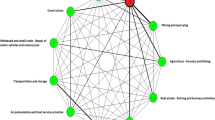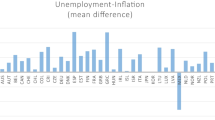Abstract
We investigate the evolution of the monetary policy transmission mechanism in the Czech Republic over the course of the 1996–2010 time period through the use of a time-varying parameters Bayesian vector autoregression model with stochastic volatility. We evaluate whether the response of GDP and the price level to exchange rate or interest rate shocks has changed over time, focusing on the period of the recent financial crisis. Our results suggest that prices have become increasingly responsive to monetary policy shocks. However, in terms of credible intervals, the stability of the monetary policy transmission mechanism in the Czech Republic cannot be rejected. Furthermore, it is demonstrated that the exchange rate pass-through has largely remained stable over time.




Similar content being viewed by others
Notes
The symbol \(\otimes \) denotes the Kronecker product.
We assume that \(S\) is block diagonal, i.e. we presume that the contemporaneous relationships among the variables evolve independently. For example, there are three blocks of \(S\) in the VAR that consists of four variables. Furthermore, to reduce the dimensionality of the estimation, we impose the condition that the matrix \(W\) must be diagonal (Kirchner et al. 2010).
This issue arises because there are no pre-1996 data available for the Czech Republic. We attempted to use data for Slovakia and the UK to construct priors; however, a simple VAR analysis revealed that the transmission mechanisms of the Czech Republic, Slovakia and the UK are not similar. For example, lagged GDP (modelled in terms of differences) produces opposite effects on GDP in the Czech Republic than in Slovakia or the UK. This discrepancy is a consequence of the restrictions imposed by the use of only two lags, a condition that is largely dictated by the methodology that is used for this study (a TVP VAR approach).
References
Baumeister C, Peersman G (2008) Time-varying effects of oil supply shocks on the US Economy. Working Papers of Faculty of Economics and Business Administration, Ghent University, Belgium 08/515, Ghent University, Faculty of Economics and Business Administration
Benati L, Surico P (2008) Evolving U.S. monetary policy and the decline of inflation predictability. J Eur Econ Assoc 6(2–3):634–646
Bianchi F, Mumtaz H, Surico P (2009) The great moderation of the term structure of UK interest rates. J Monet Econ 56(6):856–871
Borys M, Horváth R, Franta M (2009) The effects of monetary policy in the Czech Republic: an empirical study. Empirica 36(4):419–443
Canova F (1993) Modelling and forecasting exchange rates with a Bayesian time-varying coefficient model. J Econ Dyn Control 17(1–2):233–261
Canova F (2007) Methods for applied macroeconomic research. Princeton University Press, Princeton
Canova F, Nicolo GD (2002) Monetary disturbances matter for business fluctuations in the G-7. J Monet Econ 49(6):1131–1159
Canova F, Gambetti L, Pappa E (2007) The structural dynamics of output growth and inflation: some international evidence. Econ J 117(519):C167–C191
Christiano LJ, Eichenbaum M, Evans CL (1999) Monetary policy shocks: What have we learned and to what end?. In: Taylor JB, Woodford M (eds) Handbook of macroeconomics volume 1 of Handbook of macroeconomics, Chap. 2. Elsevier, Amsterdam, pp 65–148
Clarida R, Galí J, Gertler M (2000) Monetary policy rules and macroeconomic stability: evidence and some theory. Q J Econ 115(1):147–180
Cogley T, Sargent TJ (2001) Evolving post-World War II U.S. inflation dynamics. In: NBER Macroeconomics Annual 2001, vol 16, NBER Chapters. National Bureau of Economic Research, Inc., Cambridge, pp 331–388
Cogley T, Sargent TJ (2005) Drift and volatilities: monetary policies and outcomes in the post WWII U.S. Rev Econ Dyn 8(2):262–302
Darvas Z (2013) Monetary transmission in three central European economies: evidence from time-varying coefficient vector autoregressions. Empirica 40(2):363–390
Eickmeier S, Lemke W, Marcellino M (2011) The changing international transmission of financial shocks: evidence from a classical time-varying FAVAR. Discussion Paper Series 1: Economic Studies 2011, 05, Deutsche Bundesbank, Research Centre
Farrant K, Peersman G (2006) Is the exchange rate a shock absorber or a source of shocks? New empirical evidence. Journal of Money, Credit and Banking 38(4):939–961
Fry R, Pagan A (2011) Sign restrictions in structural vector autoregressions: a critical review. J Econ Lit 49(4):938–960
Geršl A (2006) Testing the effectiveness of the Czech National Bank’s foreign-exchange interventions. Czech J Econ Financ (Financ uver) 56(09–10):398–415
Havranek T, Horvath R, Mateju J (2012) Monetary transmission and the financial sector in the Czech Republic. Econ Change Restruct 45(3):135–155
Holub T, Hurnik J (2008) Ten years of Czech inflation targeting: missed targets and anchored expectations. Emerg Mark Financ Trade 44(6):67–86
Kim S, Roubini N (2000) Exchange rate anomalies in the industrial countries: a solution with a structural VAR approach. J Monet Econ 45(3):561–586
Kirchner M, Cimadomo J, Hauptmeier S (2010) Transmission of government spending shocks in the euro area: time variation and driving forces. Working Paper Series 1219. European Central Bank
Koop G, Leon-Gonzalez R, Strachan RW (2009) On the evolution of the monetary policy transmission mechanism. J Econ Dyn Control 33(4):997–1017
Mojon B, Peersman G (2001) A VAR description of the effects of monetary policy in the individual countries of the Euro area. Working Paper Series 092. European Central Bank
Mumtaz H, Sunder-Plassmann L (2010) Time-varying dynamics of the real exchange rate. A structural VAR analysis. Bank of England Working Papers 382. Bank of England
Mumtaz H, Surico P (2009) Time-varying yield curve dynamics and monetary policy. J Appl Econom 24(6):895–913
Peersman G, Smets F (2001) The monetary transmission mechanism in the Euro area: more evidence from VAR analysis. Working Paper Series 091. European Central Bank
Pereira MC, Lopes AS (2010) Time-varying fiscal policy in the U.S. Working Papers w201021, Banco de Portugal, Economics and Research Department
Primiceri G (2005) Time varying structural vector autoregressions and monetary policy. Rev Econ Stud 72:821–852
Rubio-Ramirez JF, Waggoner DF, Zha T (2010) Structural vector autoregressions: theory of identification and algorithms for inference. Rev Econ Stud 77(2):665–696
Shioji E, Uchino T (2010) Pass-through of oil prices to Japanese domestic prices. NBER Working Papers 15888, National Bureau of Economic Research, Inc.
Sims CA (1980) Macroeconomics and reality. Econometrica 48(1):1–48
Sims CA, Zha T (2006) Does monetary policy generate recessions? Macroecon Dyn 10(02):231–272
Stock JH, Watson MW (1996) Evidence on structural instability in macroeconomic time series relations. J Bus Econ Stat 14(1):11–30
Taylor JB (2000) Low inflation, pass-through, and the pricing power of firms. Eur Econ Rev 44(7):1389–1408
Uhlig H (2005) What are the effects of monetary policy on output? Results from an agnostic identification procedure. J Monet Econ 52(2):381–419
Acknowledgments
We are grateful to anonymous referee, Oxana Babecká, Tomáš Holub, Marek Jarociñski, Balázs Vonnák and seminar participants at the Czech National Bank and at the Economic Challenges in Enlarged Europe conference (Tallinn, Estonia) for helpful comments. We acknowledge financial support from the Grant Agency of Charles University (Grant Number 365111) and Grant Agency of Czech Republic (Grant P402/09/0965). The work was supported by Czech National Bank Project No. A2/2011. The views expressed here are those of the authors and not necessarily those of the Czech National Bank.
Author information
Authors and Affiliations
Corresponding author
Electronic supplementary material
Below is the link to the electronic supplementary material.
Rights and permissions
About this article
Cite this article
Franta, M., Horvath, R. & Rusnak, M. Evaluating changes in the monetary transmission mechanism in the Czech Republic. Empir Econ 46, 827–842 (2014). https://doi.org/10.1007/s00181-013-0699-0
Received:
Accepted:
Published:
Issue Date:
DOI: https://doi.org/10.1007/s00181-013-0699-0




